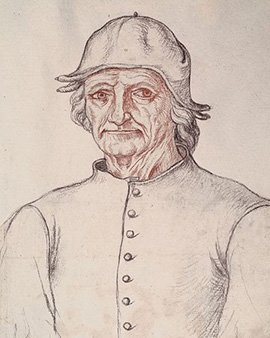Hieronymus Bosch (1450-1516), a Dutch artist, came from a family of painters in which the craft of painting had been cultivated for four generations. As the actual name van Aken indicates, the family originally came from Aachen. Hieronymus' grandfather had already moved to Hertogenbosch, he himself never left the city and his reference to it was printed in his name "Bosch", which he confidently put in his signature on the paintings. Like his two brothers, Hieronymus received his training in his father's painting workshop.
His 45 painted works can be dated to the period of upheaval between the Middle Ages and the Renaissance. Stylistically, they are committed to the tradition of Dutch art with its achievement of colourful perspective. To posterity he is known as a fantasy painter, as his paintings depict enigmatic wild monsters and mythical creatures. Inspirations for these half-men and half-animals can be found in old proverbs with all their obscenities. Bestiaries, book painting and pattern books could serve as pictorial sources for the painter. The allegorical depiction is occasionally associated with suspected heretical features of the Brotherhood of Our Lady, to which Bosch and some of his patrons belonged. The triptych "The Garden of Delights" (1500) and the triptych "The Haywagon" (1490) are world-famous.
×





.jpg)
.jpg)
.jpg)
.jpg)
 - (MeisterDrucke-56929).jpg)
 - (MeisterDrucke-56929).jpg)
.jpg)
.jpg)
.jpg)
.jpg)
_Dos_des_-_(MeisterDrucke-1031376).jpg)
_Dos_des_-_(MeisterDrucke-1031376).jpg)
.jpg)
.jpg)
.jpg)
.jpg)
 - (MeisterDrucke-606786).jpg)
 - (MeisterDrucke-606786).jpg)
.jpg)
.jpg)
.jpg)
.jpg)
.jpg)
.jpg)
.jpg)
.jpg)
.jpg)
.jpg)
.jpg)
.jpg)
.jpg)
.jpg)
.jpg)
.jpg)
.jpg)
.jpg)
.jpg)
.jpg)
.jpg)
.jpg)
.jpg)
.jpg)
.jpg)
.jpg)
.jpg)
.jpg)
.jpg)
.jpg)
.jpg)
.jpg)
 (see also 821 35965 59834 67838 67839) - (MeisterDrucke-90807).jpg)
 (see also 821 35965 59834 67838 67839) - (MeisterDrucke-90807).jpg)
.jpg)
.jpg)
.jpg)
.jpg)
_-_(MeisterDrucke-1453077).jpg)
_-_(MeisterDrucke-1453077).jpg)
.jpg)
.jpg)
.jpg)
.jpg)
.jpg)
.jpg)
.jpg)
.jpg)
.jpg)
.jpg)
.jpg)
.jpg)
.jpg)
.jpg)
.jpg)
.jpg)
.jpg)
.jpg)
.jpg)
.jpg)
.jpg)
.jpg)
.jpg)
.jpg)
.jpg)
.jpg)
_-_(MeisterDrucke-1062922).jpg)
_-_(MeisterDrucke-1062922).jpg)
.jpg)
.jpg)
.jpg)
.jpg)
.jpg)
.jpg)
.jpg)
.jpg)
.jpg)
.jpg)
.jpg)
.jpg)
.jpg)
.jpg)
 (detail of 59834) (see also 35965 44162 59834 67838 67839 and 29108) - (MeisterDrucke-55301).jpg)
 (detail of 59834) (see also 35965 44162 59834 67838 67839 and 29108) - (MeisterDrucke-55301).jpg)
 - (MeisterDrucke-67629).jpg)
 - (MeisterDrucke-67629).jpg)
.jpg)
.jpg)
.jpg)
.jpg)
.jpg)
.jpg)
.jpg)
.jpg)
 (see also 821 44162 59834 67838 67839) - (MeisterDrucke-82118).jpg)
 (see also 821 44162 59834 67838 67839) - (MeisterDrucke-82118).jpg)
 - (MeisterDrucke-84892).jpg)
 - (MeisterDrucke-84892).jpg)
.jpg)
.jpg)
.jpg)
.jpg)
.jpg)
.jpg)
.jpg)
.jpg)
.jpg)
.jpg)
 - (MeisterDrucke-107382).jpg)
 - (MeisterDrucke-107382).jpg)
_Linke_Tafel_Um_1515_-_(MeisterDrucke-804593).jpg)
_Linke_Tafel_Um_1515_-_(MeisterDrucke-804593).jpg)
.jpg)
.jpg)
 - (MeisterDrucke-97335).jpg)
 - (MeisterDrucke-97335).jpg)
.jpg)
.jpg)
.jpg)
.jpg)
_Linke_Tafel_Um_1515_-_(MeisterDrucke-803968).jpg)
_Linke_Tafel_Um_1515_-_(MeisterDrucke-803968).jpg)
.jpg)
.jpg)
.jpg)
.jpg)
.jpg)
.jpg)
.jpg)
.jpg)
.jpg)
.jpg)
.jpg)
.jpg)
 - (MeisterDrucke-64461).jpg)
 - (MeisterDrucke-64461).jpg)
.jpg)
.jpg)
 - (MeisterDrucke-107250).jpg)
 - (MeisterDrucke-107250).jpg)
.jpg)
.jpg)
.jpg)
.jpg)
.jpg)
.jpg)
.jpg)
.jpg)
_-_(MeisterDrucke-1466596).jpg)
_-_(MeisterDrucke-1466596).jpg)
.jpg)
.jpg)
.jpg)
.jpg)
.jpg)
.jpg)
.jpg)
.jpg)
.jpg)
.jpg)
.jpg)
.jpg)
.jpg)
.jpg)
.jpg)
.jpg)
_-_(MeisterDrucke-1665085).jpg)
_-_(MeisterDrucke-1665085).jpg)
.jpg)
.jpg)
.jpg)
.jpg)
.jpg)
.jpg)
.jpg)
.jpg)
.jpg)
.jpg)
.jpg)
.jpg)
.jpg)
.jpg)






